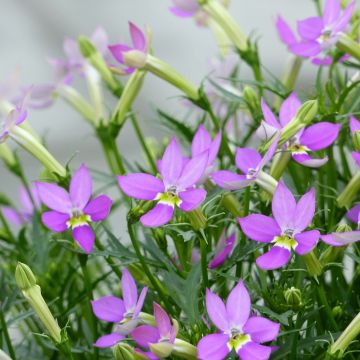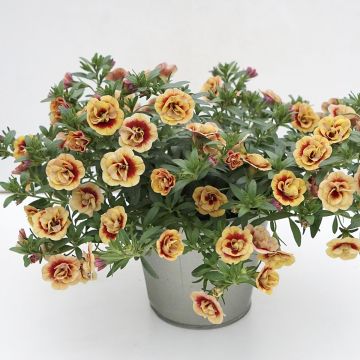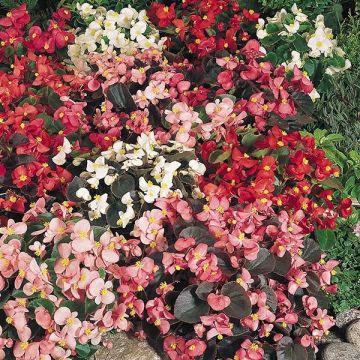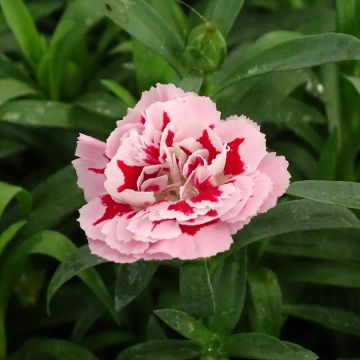

Heliotropium arborescens Marine - Garden Heliotrope


Heliotropium arborescens Marine - Garden Heliotrope
Heliotropium arborescens Marine - Garden Heliotrope
Heliotropium arborescens Marine
Garden Heliotrope, Cherry pie plant
Out of 10 plug plants, 2 arrived completely dried up! Totally disappointed.
Tony, 02/05/2024
This item cannot be shipped to the selected country
Delivery charge from 5,90 €
Delivery to Corse prohibited
More information
Shipping country:
-
Andorra
-
Austria
-
Belgium
-
Bulgaria
-
Chile
-
Croatia
-
Cyprus
-
Czechia
-
Denmark
-
Estonia
-
Finland
-
France
-
Germany
-
Greece
-
Hungary
-
Iceland
-
Ireland
-
Italy
-
Latvia
-
Lithuania
-
Luxembourg
-
Malta
-
Monaco
-
Netherlands
-
Poland
-
Portugal
-
Romania
-
Slovakia
-
Slovenia
-
Spain
-
Sweden
-
Switzerland
-
United Kingdom
Schedule delivery date,
and select date in basket
This plant carries a 6 months recovery warranty
More information
We guarantee the quality of our plants for a full growing cycle, and will replace at our expense any plant that fails to recover under normal climatic and planting conditions.
From 5,90 € for pickup delivery and 6,90 € for home delivery
Express home delivery from 8,90 €.
Delivery to Corse prohibited: UE law prohibits the import of this plant from mainland France to Corse as part of the fight against Xylella fastidiosa. Please accept our sincere apologies.
More information
Would this plant suit my garden?
Set up your Plantfit profile →
Description
The 'Marine' Heliotrope is a famous variety of Peruvian Heliotrope with a fragrant dark blue flowering. Its flower umbels appear throughout the summer and autumn, filling the garden or terrace with fragrance in the evening. This tender shrubby perennial is often grown as a summer annual. It is also a beautiful plant for an orangery or conservatory, and easy to cultivate.
The Peruvian Heliotrope 'Marine' is a horticultural selection derived from Heliotropium arborescens (synonym: Heliotropium peruvianum), also known as "Saint-Fiacre's Herb", a botanical species belonging to the Boraginaceae family native to South America, particularly the highlands of southern Peru. In the wild, it is a bushy shrub. It can be grown in a pot (protected from frost in winter) or in the ground as a perennial. Its hardiness does not exceed -4 °C (24.8°F) at its lowest.
The 'Marine' Heliotrope quickly forms a well-branched bushy clump reaching about 40cm (16in) in all directions. Its stems, which lignify as they age, bear leaves that are 3 to 8cm (1 to 3in) long, ovate, puckered, rough to the touch, and a very dark green. The small flowers, in shades of dark blue-violet, are grouped in irregular, wide inflorescences measuring 10 to 15cm (4 to 6in) in diameter. They exude a sweet fragrance with hints of vanilla and bitter almond, especially in the evening after a warm day. This flowering period lasts from July to October, or even until January for a plant grown in a conservatory. The leaves theoretically persist in winter.
The Peruvian Heliotrope was very popular during the Belle Époque, it has a somewhat theatrical charm, just like Gloxinias. It pairs perfectly with yellow to orange flowers and silver foliage in summer borders or containers. To accompany it, consider coastal Cinerarias, Artemisias, Nemophila, and California poppies...
Note: Please be aware that our plug plants are professional products intended for experienced gardeners. Upon receipt, transplant and store them in a sheltered location (conservatory, greenhouse, cold frame...) at a temperature above 14 °C (57.2°F) for a few weeks before planting them outdoors once the risk of frost has passed.
Report an error about the product description
Heliotropium arborescens Marine - Garden Heliotrope in pictures




Flowering
Foliage
Plant habit
Botanical data
Heliotropium
arborescens
Marine
Boraginaceae
Garden Heliotrope, Cherry pie plant
Cultivar or hybrid
Other Annuals A to Z
Planting and care
Heliotropium arborescens 'Marine' is planted in May, spaced 30-40cm (12-16in) apart, in a fresh, rich, humus-rich and well-drained soil, in full sun, sheltered from the wind. Beware of powdery mildew. Susceptible to frost below -4 °C, this plant is grown as a summer annual or in a pot to overwinter indoors. Regularly apply fertilizer to potted plants.
Planting period
Intended location
Care
-
, onOrder confirmed
Reply from on Promesse de fleurs
Plug plants - Annuals
Haven't found what you were looking for?
Hardiness is the lowest winter temperature a plant can endure without suffering serious damage or even dying. However, hardiness is affected by location (a sheltered area, such as a patio), protection (winter cover) and soil type (hardiness is improved by well-drained soil).

Photo Sharing Terms & Conditions
In order to encourage gardeners to interact and share their experiences, Promesse de fleurs offers various media enabling content to be uploaded onto its Site - in particular via the ‘Photo sharing’ module.
The User agrees to refrain from:
- Posting any content that is illegal, prejudicial, insulting, racist, inciteful to hatred, revisionist, contrary to public decency, that infringes on privacy or on the privacy rights of third parties, in particular the publicity rights of persons and goods, intellectual property rights, or the right to privacy.
- Submitting content on behalf of a third party;
- Impersonate the identity of a third party and/or publish any personal information about a third party;
In general, the User undertakes to refrain from any unethical behaviour.
All Content (in particular text, comments, files, images, photos, videos, creative works, etc.), which may be subject to property or intellectual property rights, image or other private rights, shall remain the property of the User, subject to the limited rights granted by the terms of the licence granted by Promesse de fleurs as stated below. Users are at liberty to publish or not to publish such Content on the Site, notably via the ‘Photo Sharing’ facility, and accept that this Content shall be made public and freely accessible, notably on the Internet.
Users further acknowledge, undertake to have ,and guarantee that they hold all necessary rights and permissions to publish such material on the Site, in particular with regard to the legislation in force pertaining to any privacy, property, intellectual property, image, or contractual rights, or rights of any other nature. By publishing such Content on the Site, Users acknowledge accepting full liability as publishers of the Content within the meaning of the law, and grant Promesse de fleurs, free of charge, an inclusive, worldwide licence for the said Content for the entire duration of its publication, including all reproduction, representation, up/downloading, displaying, performing, transmission, and storage rights.
Users also grant permission for their name to be linked to the Content and accept that this link may not always be made available.
By engaging in posting material, Users consent to their Content becoming automatically accessible on the Internet, in particular on other sites and/or blogs and/or web pages of the Promesse de fleurs site, including in particular social pages and the Promesse de fleurs catalogue.
Users may secure the removal of entrusted content free of charge by issuing a simple request via our contact form.
The flowering period indicated on our website applies to countries and regions located in USDA zone 8 (France, the United Kingdom, Ireland, the Netherlands, etc.)
It will vary according to where you live:
- In zones 9 to 10 (Italy, Spain, Greece, etc.), flowering will occur about 2 to 4 weeks earlier.
- In zones 6 to 7 (Germany, Poland, Slovenia, and lower mountainous regions), flowering will be delayed by 2 to 3 weeks.
- In zone 5 (Central Europe, Scandinavia), blooming will be delayed by 3 to 5 weeks.
In temperate climates, pruning of spring-flowering shrubs (forsythia, spireas, etc.) should be done just after flowering.
Pruning of summer-flowering shrubs (Indian Lilac, Perovskia, etc.) can be done in winter or spring.
In cold regions as well as with frost-sensitive plants, avoid pruning too early when severe frosts may still occur.
The planting period indicated on our website applies to countries and regions located in USDA zone 8 (France, United Kingdom, Ireland, Netherlands).
It will vary according to where you live:
- In Mediterranean zones (Marseille, Madrid, Milan, etc.), autumn and winter are the best planting periods.
- In continental zones (Strasbourg, Munich, Vienna, etc.), delay planting by 2 to 3 weeks in spring and bring it forward by 2 to 4 weeks in autumn.
- In mountainous regions (the Alps, Pyrenees, Carpathians, etc.), it is best to plant in late spring (May-June) or late summer (August-September).
The harvesting period indicated on our website applies to countries and regions in USDA zone 8 (France, England, Ireland, the Netherlands).
In colder areas (Scandinavia, Poland, Austria...) fruit and vegetable harvests are likely to be delayed by 3-4 weeks.
In warmer areas (Italy, Spain, Greece, etc.), harvesting will probably take place earlier, depending on weather conditions.
The sowing periods indicated on our website apply to countries and regions within USDA Zone 8 (France, UK, Ireland, Netherlands).
In colder areas (Scandinavia, Poland, Austria...), delay any outdoor sowing by 3-4 weeks, or sow under glass.
In warmer climes (Italy, Spain, Greece, etc.), bring outdoor sowing forward by a few weeks.






















